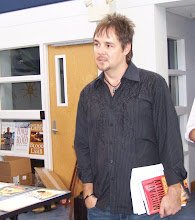
A man and a woman.
A mother and a father.
Divorced.
Having failed in relationships, trying again.
After dating a while, they’re ready to have sex—or think they are.
Nervous.
Scared.
Risking. Pressing through.
Then, suddenly, they go from awkward and uncomfortable to her crying and him unable to continue.
Is it possible you might be who I need you to be? she asks.
It is. He is—and is not. And that’s life—or at least a reflection of it—art that is a recognizable reflection of human experiences more than a few of us are likely to have.
It’s a tender, true, affecting scene—one of many, not from a feature film, but from a network television show.
There are actually “film” people who disdain television, as if those who work in it—writers, directors, actors, producers—are less somehow, as if the screen size isn’t the only thing that’s smaller. But some of the very best filmed fiction is made for television. Shows like “Buffy the Vampire Slayer,” “Six Feet Under,” “Gilmore Girls,” “House,” “Mad Men,” and others are as good as anything on offer at the local movie theater—and these series are doing the equivalent of several feature-length films season after season.
If it’s true that TV is a writer’s medium and film is a director’s, it stands to reason that the best television has to offer will be richer, deeper, more intellectual and emotionally satisfying than all but the very best movies. Television allows for the time it takes to tell a complex tale while truly exploring the characters propelling it forward. It’s why in general, novels adapt better to TV than film. It’s also why so many accomplished and acclaimed writers, producers, actors, and even directors are drawn to television—particularly cable.
Recently, “Entertainment Weekly” listed what it deems as the five best divorce movies ever: “Kramer vs. Kramer,” “The Philadelphia Story,” “The War of the Roses,” “An Unmarried Woman,” and “The Odd Couple,” and maybe they are, but none of them delves as deeply or does so with such sustained exploration as does a too-early canceled TV show.
Divorce is death. A painful end to something at one point you never wanted to end—and maybe still don’t. Failure. Rejection. Disappointment. Embarrassment.
Divorce is death, yet life continues. Not only your life, but that of your onetime spouse. Like an apparition, your ex haunts your life, a continual reminder of what was, of what might have been, of what is, of what can never be.
Divorce opens a family up and invites new people in. Lawyers. Counselors. Friends. Lovers. Strangers.
In the best of situations, divorce is difficult.
And this difficulty is handled deftly in the divorce drama, “Once and Again”—one of the best adult hour-long dramas network television has ever produced.
Lily Manning (played by the breathtakingly beautiful and perfectly cast, Sela Ward) is a 40ish suburban soccer mom living in Deerfield, Illinois. Recently separated from her philandering husband Jake (Jeffrey Nordling), Lily is raising her two daughters, insecure, anxiety-ridden 14-year-old Grace (Julia Whelan), and wide-eyed, innocent 9-year-old Zoe (Meredith Deane). For support, she turns to her more free-spirited younger sister, Judy (Marin Hinkle), with whom she works at their bookstore called My Sister's Bookstore.
Lily’s life changes when she meets Rick Sammler (Billy Campbell) in the principal’s office of Grace’s school. Rick is a single father and co-head of an architectural firm, Sammler/Cassili Associates, which is located in downtown Chicago. Rick has been divorced from the rigid Karen (Susanna Thompson) for three years and has two children, Eli (Shane West), a 16-year-old basketball player with a learning disability, and sensitive 12-year-old Jessie (Evan Rachel Wood), who longs for the days before her family’s disintegration.
Lily and Rick share an immediate mutual attraction and begin dating. Their budding relationship causes problems in both of their respective families. Grace strongly objects to Lily and Rick’s relationship as she still hopes to see her parents get back together. Karen, a public interest attorney at the downtown law firm of Harris, Riegert, and Sammler, is worried about the toll Rick’s new relationship would take on their children, particularly Jessie, who is shy and emotionally fragile. She is also working through her own feelings of jealousy that Rick is in a new serious relationship.
“Once and Again” was created by Marshall Herskovitz and Edward Zwick, the same team behind “Thirtysomething,” and both shows demonstrate their brilliance for dramas that capture the nuance of entire epochs of modern American life.
Though the show begins with and centers around the romance and relationship between Lily and Rick, it also deals extensively with their children and to a lesser degree with their exes, Jake and Karen, and their ongoing struggles to find peace, joy, and love in the post-divorce environment.
Like “Thirtysomething,” “Once and Again” is smart, literate, well-written, affecting, timely, timeless, and dramatic without too often being melodramatic.
It’s also at times dizzily, intoxicatingly, wildly romantic. Rick and Lily have an earned and unexpected intensity and intimacy that combines the best of heady, youthful infatuation with the scars and wisdom age and experience and rejection and failure and the disappointment that divorce brings.
Few things are as therapeutic as talking. Few things need the healing therapy talk can bring as much as divorce. Each episode of “Once and Again,” as they’re dealing with divorce and death and life and love and betrayal and fear and loss and hope, has the characters, shot in black and white, sit and talk—to us, the audience, making us their therapist, making us privy to their most hidden thoughts and feelings, making us more complicit in their lies and lives—and more compassionate. This makes TV more like a book—we know what characters are thinking, get to be in their heads, know what the other characters they interacting with cannot.
In “Once and Again,” as in life, the past is prologue. Everything that comes around, comes around, not just once, but again. And again. Every seeming new issue in every seeming new relationship bares an amazing similarity to the issues and relationships that came before. We are products. We are patterns. We have dynamics, issues, wounds, experiences. We carry who we are into each new relationship, including what we’ve learned and lost, gained and changed, which makes the biggest part of our new relationships not new at all.
Divorce is difficult and dramatic and traumatic, and there’s no one who hasn’t been touched by its ripples. Fortunately, through story, we can learn and heal and grow and become more and better, and be our best selves even in brokenness, and, as far as divorce dramas go, “Once and Again” is a good place to start. Give it a try. You might watch it once. Or, like me, you might watch it again and again.












No comments:
Post a Comment